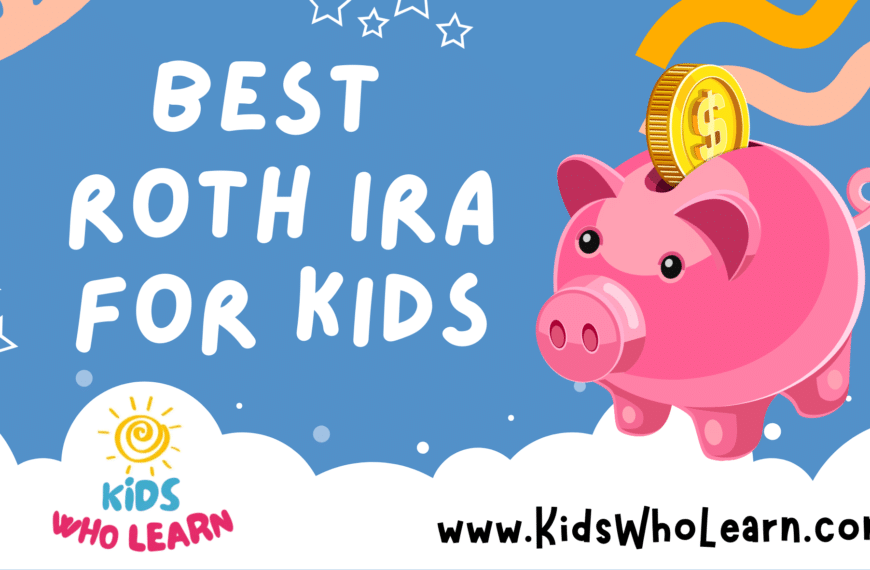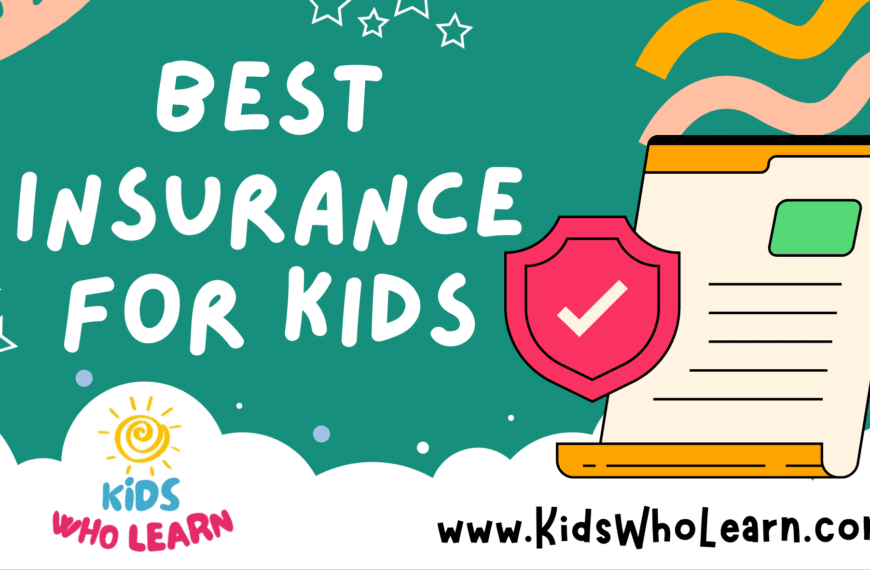Selecting the best bank for your child is an important step in teaching them financial responsibility and money managemennt skills. As a parent or guardian, you want to find a financial institution that offers not only safe saving options but also educational resources that cater to the needs of young savers. The right bank can provide a solid foundation for your child’s financial literacy and help them understand the value of money from an early age.
When searching for the best bank for kids, it’s essential to consider the types of accounts available, their features, and how they align with your child’s age and understanding level. Many banks offer accounts specifically designed for minors with attractive benefits like no maintenance fees, competitive interest rates, and online learning tools. These accounts often come hand-in-hand with resources and programs aimed at teaching children about saving, earning interest, and the basics of personal finance.
Key Takeaways
- Identifying a bank that offers educational resources can help teach children financial responsibility.
- It is important to compare account features tailored for young individuals.
- Choosing an appropriate bank involves evaluating tools for money management and financial education.
Understanding Banking for Kids
When introducing your child to the world of banking, you’ll encounter a variety of terms and services. A savings account is fundamental to personal finance, designed to store money and accumulate interest over time. It’s a safe and incremental way to teach kids about the value of savings.
At the core of daily financial transactions is the checking account. This account is used for frequent deposits and withdrawals, providing a hands-on way to manage money through physical or digital banking platforms.
Bank accounts for kids often combine elements of both savings and checking accounts, tailored to provide a practical, real-world experience while maintaining safeguards suited for minors. These accounts can be found at both traditional banks and online banks.
Some institutions, such as credit unions, offer a more community-oriented approach. Credit unions may provide more favorable interest rates and a member-focused service model, an alternative to national banks.
To ensure your child is competent in financial literacy, you can also explore tools and services geared towards education in managing money and understanding personal finance. Many banks offer educational resources to complement their child-friendly account offerings.
Here’s a table to summarize the options:
| Account Type | Purpose | Benefits |
|---|---|---|
| Savings | Store money | Earns interest, teaches savings |
| Checking | Daily transactions | Hands-on money management |
| Kids’ Accounts | Education & savings | Tailored for learning, safety features |
Your choice between these options will shape your child’s journey toward financial independence and confidence in the realm of personal finance.
Types of Accounts and Features
When selecting a bank account for your child, it is important to consider the specific features and types of accounts available. Options range from purely savings-focused accounts to more flexible checking accounts with debit capabilities, each catering to different ages and financial education levels.
Savings Accounts for Kids
Alliant Credit Union Kids Savings Account:
- Interest Rate/APY: Competitive high-yield offering, currently up to 0.55% APY.
- Minimum Balance Requirements: None, making it accessible for kids to start saving.
- Fees: No monthly service fees, promoting long-term savings.
Capital One Kids Savings Account:
- Interest Rate/APY: Offers an attractive APY to help grow savings faster through compound interest.
- Minimum Balance Requirements: No minimum to open or maintain, providing flexibility.
- Fees: No monthly fees, enabling kids to keep all of their savings.
These accounts are aimed at teaching the value of saving and the benefits of compound interest. They are typically the best savings account options for kids, promoting long-term financial responsibility.
Checking Accounts and Debit Cards for Teens
First Checking Accounts:
- Account Features: Specially designed for teens, these accounts often include a debit card for everyday purchases.
- Minimum Balance Requirements: Usually, there are no minimum balance requirements, fostering financial independence.
- Fees: Most teen checking accounts do not charge monthly fees, making them cost-effective for young users.
- Provides a safe and controlled way for teenagers to learn money management.
- Often these cards come with parental oversight features, ensuring security and responsible usage.
These accounts help bridge the transition to adult financial tools, focusing on helping teens manage money in a real-world context without some of the risks associated with credit cards.
Custodial and Joint Accounts
Custodial Accounts:
- Custodian Control: You maintain control of the account until your child reaches the age of majority.
- Long-Term Savings: Ideal for those looking to save for their children’s future expenses like college tuition.
Joint Accounts:
- Shared Oversight: Both you and your child can access the account, enabling you to monitor and guide financial habits.
- Account Features: Combines the benefits of savings and checking accounts, often with the potential for an attached debit card.
Both options foster a collaborative approach to banking and financial education, with custodial accounts offering more control to the parent and joint accounts providing a shared banking experience.
Choosing the Right Bank
When selecting the best bank for your child, it’s crucial to consider several specific factors to ensure financial success and education.
Criteria for Selecting the Best Bank
Your primary focus should be on minimum deposit requirements and monthly fees. Look for banks that require a low or no minimum deposit to make it accessible for your child to open an account. Additionally, opt for banks that either don’t charge a monthly fee or offer ways to avoid it.
It’s also essential to examine the fees structure, including ATM fees, especially if your child will be using ATMs frequently. Look for banks that offer a robust network of fee-free ATMs. Furthermore, ensure that the bank provides FDIC insurance to protect the deposits.
When considering a savings account for kids, search for ones providing a competitive interest rate to encourage the habit of saving. The aspect of parental controls is critical for monitoring and guiding your child’s spending and saving habits.
Lastly, the choice between traditional banks and credit unions like Alliant Credit Union or Spectrum Credit Union should be informed by your preference for nonprofit institutions and eligibility for membership.
Review of Top Banks and Credit Unions
Here is a brief overview of some notable financial institutions:
- Alliant Credit Union: Offers a high-interest savings account with no minimum deposit and access to over 80,000 fee-free ATMs. Requires membership, which is often easy to establish.
- Capital One & Capital One 360: Known for having no minimum deposit and no monthly fee, these options also include mobile-friendly parental controls.
- PNC Bank: Provides a ‘S’ is for Savings account featuring interactive banking experience. Beware of potential monthly fees.
- BECU: As a credit union, BECU promotes no monthly fee savings accounts and has a lower threshold for minimum deposits.
- Spectrum Credit Union: Offers competitive rates and is part of a broad network of ATMs. Requires membership and is nonprofit like most credit unions.
Keep these specifics in mind to navigate towards the best banking choice for your child.
Financial Tools and Resources
Choosing the best bank for your children involves finding one that provides robust financial tools and resources designed to teach and empower them. The right selection should include engaging educational programs, user-friendly mobile banking options, and carefully tailored accounts to fit their needs.
Educational Programs and Apps
Most leading banks offer Educational Programs and Apps that provide financial education tailored for children. For example, Chase First Banking, in partnership with Sesame Street, brings familiar characters to help teach money basics. Similarly, mobile apps like GoHenry and Greenlight combine hands-on money management with educational content, making learning interactive and fun for your teen. These platforms often allow children to track their savings, set goals, and learn budgeting skills in a controlled environment under a parent’s supervision.
- Chase First Banking: Endorsed by Sesame Street for learning basic finance.
- GoHenry: Offers interactive learning modules.
- Greenlight: Includes real-time requests for money and automated allowances.
Online and Mobile Banking
Banks have incorporated Online and Mobile Banking to suit the needs of digitally-savvy children and teens. Axos Bank provides Axos First Checking, which is an online-only account accessible through their online banking and mobile banking app. This online interface and app combo are designed with youngsters in mind, ensuring their experience is as hassle-free as the application process itself.
- Axos Bank: Offers a simplified application process for teen-centric accounts.
- Axos First Checking: Gives access to a user-friendly digital banking experience.
- Mobile App: Enables tracking of expenses and easy account management.
All these tools are key in helping your kids become financially savvy and independent in today’s digital world.
Money Management and Education for Youth
Effective money management and education are crucial in shaping the financial habits of youth. Your understanding of saving, budgeting, earning, and spending can lead to responsible money habits that last a lifetime.
Teaching Kids About Saving and Budgeting
Saving should be introduced to children as a foundational concept. Encouraging your child to set aside a portion of any unearned income like gifts or allowances instills the principle of saving. Use clear, visual tools like:
- Savings chart: A simple table that tracks savings progress.
Week Amount Saved Total Savings 1 $5.00 $5.00 2 $5.00 $10.00 … … … - Piggy banks or clear jars: These help kids see their money grow.
Budgeting is about decisions. When you give your children a budget for something like their school supplies, you are teaching them to make choices based on their priorities. Here are some steps to take:
- Identify total available funds.
- List necessary items with their prices.
- Differentiate between wants and needs.
- Allocate funds accordingly, keeping long-term savings goals in mind.
Incorporating these practices early promotes healthy financial habits.
Financial Planning for Teens
As teens grow older, concepts such as building credit and more complex forms of financial planning become relevant. Teach your teenager about the importance of credit by:
- Discussing the use of a student credit card for small, regular purchases.
- Emphasizing the importance of paying the card balance in full each month.
Understanding how to manage and transfer funds is another crucial skill:
- Set up a checking account they can manage.
- Introduce tools for setting up automated allowances or automatic transfers to savings accounts.
This autonomy encourages teens to practice managing their funds responsibly and sets a cornerstone for robust money habits. Engaging with financial tools and resources can also help your teenager set and reach long-term savings goals, further solidifying strong financial planning techniques.
Banking Benefits and Considerations
When selecting a bank for kids, you should weigh the benefits against the practical considerations of the account. Begin by evaluating no fees or low fees structures. These are crucial as they ensure that the savings your child accumulates are not eroded over time by charges.
| Benefit | Consideration |
|---|---|
| No monthly fees | Availability of ATMs |
| Low or no overdraft fees | Minimum balance requirements |
| Competitive APYs | Access to educational resources |
Consider banks with high interest rates or competitive APYs (Annual Percentage Yields), as they can significantly increase your child’s savings over time. However, take note of any monthly fees such as monthly service fee or monthly maintenance fees that might offset the accrued interest.
Watch out for overdraft fees, especially if your child is just learning to manage their account. Look for accounts that offer overdraft protection or do not allow overdrafts at all, protecting your child from unexpected fees.
In conclusion, your best choice will be an account that balances these factors to benefit your child’s financial growth while instilling fiscal responsibility without unnecessary costs.
Frequently Asked Questions
Before jumping into specifics, it’s crucial for you to understand what banking features are most appropriate for children at different stages of their development, and how to navigate various banking institutions offering these services.
What features should you look for in a child’s checking account?
When selecting a checking account for your child, consider accounts with no maintenance fees, low minimum balance requirements, and educational resources. It’s also beneficial to choose an account that offers parental controls to monitor spending.
Which banks offer the most beneficial savings accounts for children?
Banks that provide high interest rates for savings accounts, no monthly fees, and tools for financial learning tend to be very beneficial for children. Examples include Ally Bank and Capital One Kids Savings Account, both of which encourage good savings habits early on.
How can you compare online banks to traditional banks for kids’ financial products?
To compare online banks with traditional banks, look at fees, interest rates, accessibility, and educational tools. Online banks often offer higher interest rates and lower fees, while traditional banks may provide in-person banking experiences that can be invaluable for kids’ financial education.
Are there specific accounts suitable for teenagers that come with a debit card?
Yes, many banks offer youth or teen accounts that come with a debit card. For example, Chase High School Checking and Wells Fargo Clear Access Banking are tailored for teenagers, providing a debit card and oversight features for parents or guardians.
At what age should you consider opening a bank account for your child?
You can consider opening a bank account for your child as soon as you feel they’re ready to learn about money management. Typically, this can be as young as 6 to 8 years old when they start receiving allowance or money as gifts.
What are the advantages of opening a credit union account for children over traditional banks?
Credit unions often offer lower fees and higher savings rates compared to traditional banks. Additionally, credit unions are member-owned and may provide a more personalized and community-focused banking experience for your child.











